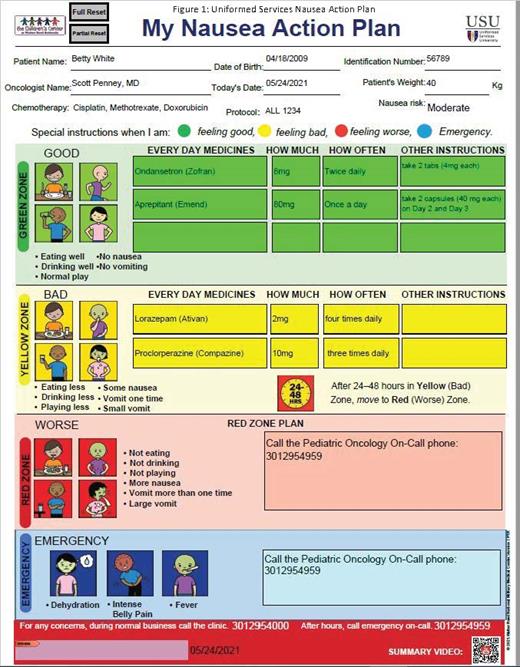Abstract
Objective
Chemotherapy-induced nausea and vomiting (CINV) is characterized by disabling nausea and emesis that can recur throughout the treatment of cancer and affects approximately 59% of pediatric and young adult patients. CINV can be associated with significant clinical morbidity, frequent hospital admissions, negative effects on health care related quality-of-life and can exhibit downstream effects such as weight loss that can worsen overall outcomes. Despite the vast number and potential combinations of pharmacotherapies and lifestyle modifications available to manage CINV in children, there are currently no clinical action tools offered to manage this condition better at home. We aimed to develop and assess an evidence-based, personalized pictogram-based nausea action plan (NAP) to aid providers, parents, and patients in the management of CINV.
Methods
The USNAP (Figure 1) facilitates the management of CINV by using a health literacy-informed approach to provide instructions for pharmacotherapies and lifestyle modifications. This study included Part 1 (Pictogram Validation) and Part 2 (Assessment).
For Part 1, Pictogram transparency, translucency, and recall were assessed by parent survey with transparency ≥85%, mean translucency score ≥5, recall ≥85% required for validation.
For Part 2, the USNAP was assessed by parents, clinical librarians, and clinicians. Patient/caregiver perceptions (n=27) were assessed using the Consumer Information Rating Form (17 questions) to gauge comprehension, design quality and usefulness. Readability was assessed by 5 formulas and a Readability Consensus Score was calculated. Clinical Librarians (n=2) used the Patient Education Materials Assessment Tool to measure the understandability (19 questions) and actionability (7 questions) of the plan and audiovisual educational content (>80% acceptable.) Suitability was assessed by clinicians (n=16) using Doaks' Suitability Assessment of Materials (superior≥70% rating).
Results
All 15 pictograms demonstrated appropriate transparency, translucency, and recall. Patient/caregiver perceptions reflected appropriate comprehension, design quality, and usefulness. The Readability Composite Score measured at a fourth-grade level. Clinical librarians reported acceptable understandability and actionability. Clinicians reported superior suitability.
Conclusion
The Uniformed Services Nausea Action Plan (USNAP) is the first clinical action tool designed to assist in managing CINV at home. Although recent clinical practice updates provide guidance on the therapeutic management of CINV in pediatric and young adult patients with cancer, these recommendations do not fully address the needs of the patient at home or adequately inform in instances of low health literacy. The USNAP seeks to mitigate this by making the clinical practice guidance useful to patients and caregivers at home. In addition, the USNAP is poised to identify other urgent clinical developments for patients with cancer that could masquerade as nausea and may serve as an early warning sign in these instances. The USNAP met all criteria for clinical implementation. The USNAP has potential to become an important tool in the care of patients with CINV, improving both quality-of-care and clinical outcomes. Future study of USNAP implementation for treating children with chronic CINV is needed.
No relevant conflicts of interest to declare.


This feature is available to Subscribers Only
Sign In or Create an Account Close Modal